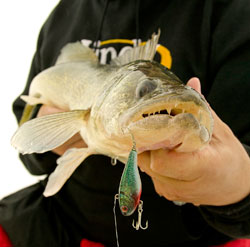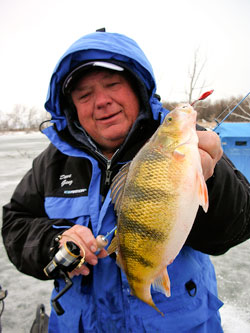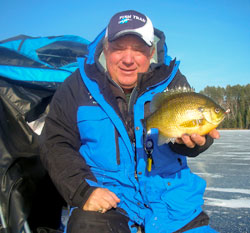 It was cold, but it was also cloudy, so on this day, Dave Genz chose to target shallow-water bluegills. An excellent decision, as you can see. Had it been a high-sky, high-pressure day, Genz might have elected to go after deeper-water jumbo perch instead.
It was cold, but it was also cloudy, so on this day, Dave Genz chose to target shallow-water bluegills. An excellent decision, as you can see. Had it been a high-sky, high-pressure day, Genz might have elected to go after deeper-water jumbo perch instead.

Small Ball Ice Fishing
By Ted Takasaki and Scott Richardson
Modern ice fishing methods have increased our enjoyment of the sport with advanced electronics, underwater cameras, and space age shelters/clothes which keep you warm. New tackle is also keeping anglers on the cutting edge. Rattles, high intensity glow colors and innovative shapes are catching more fish than ever before. But as intense angling pressure is affecting many of our lakes, the fish are slowly adapting to more subtle presentations. That's where 'small ball' fishing is taking shape. Small Ball fishing is downsizing your jigs, hooks, and bait. If the loud, flashy, and vigorous action is not working, then start going small.
ICE FISHING

Rigging Spikes
By: Justin Clark

The Time is Now for BIG Gills!
By: Brad Kamps
A Bluegill Outing
By: Greg Clusiau
His Season
By: The Trout Whisperer
Getting Kids Started: It's about Them and Their Fishing
By: Mark Strand

Zooplankton Triggers Everything!
By: Mark Strand

Plan for Ice Fishing Success
By: Mark Strand

Late Ice Sight Fishing Secrets
By Dave Genz

Late Ice Transition Time
By Dave Genz

Aggressive Tactics for First-Ice Walleyes
By Ted Takasaki and Scott Richardson

Early Morning: Most-Missed Ice Fishing Opportunity
By Dave Genz

Early Ice is Set by Fall
By Dave Genz
Why 'Poofing' Bottom Works
By Dave Genz
Daytime Demands Mobility
By: Mark Strand
Essential Modern Ice Fishing Basics
By Mark Strand
North Bays, Big Lakes, Late Ice
By: Mark Strand
Ice Fishing for Lucky Lakers on Crow
By: Dave Bonke
Ice Plastics are all the Rave
By Ted Takasaki and Scott Richardson
Genz on Spoon-Feeding Winter Walleyes
By: Ted Takasaki and Scott Richardson
Ice Fishing Preparation
By Ted Takasaki and Scott Richardson



